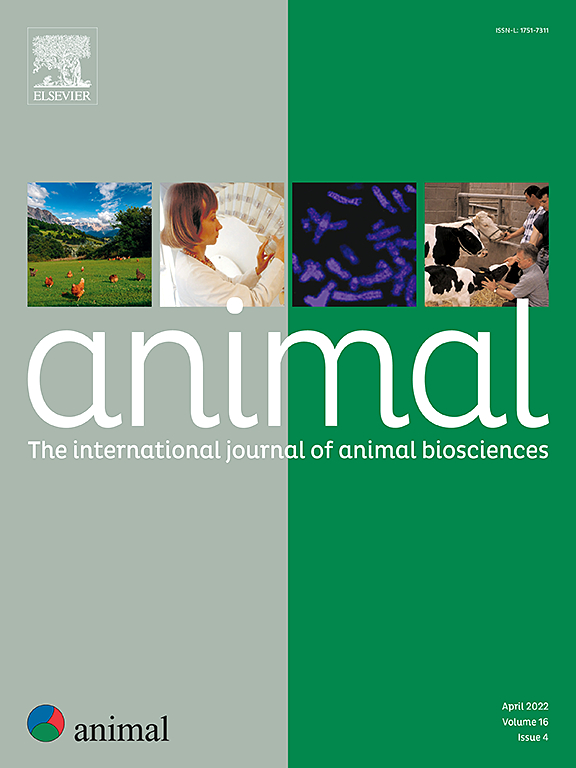Review: Exploring correctness, usefulness, and feasibility of potential physiological operational welfare indicators for farmed insects to establish research priorities
IF 4.2
2区 农林科学
Q1 AGRICULTURE, DAIRY & ANIMAL SCIENCE
引用次数: 0
Abstract
While insects are already the largest group of terrestrial food and feed livestock animals in terms of absolute number of individuals, the insect farming industry is expected to continue growing rapidly in order to meet the nutritional demands of the human population during the 21st century. Accordingly, consumers, producers, legislators, and industry-adjacent researchers have expressed interest in further research and assessment of farmed insect welfare. Operational indicators of animal welfare are those that can be used to putatively assess the welfare of animals in the absence of true indicators of affective state (e.g., valenced/emotional state) and are commonly used for farmed vertebrate livestock species; however, significant behavioral and physiological differences between vertebrates and insects means these indicators must be examined for their correctness, usefulness, and feasibility prior to use with insect livestock. The most valuable operational welfare indicators would (1) correctly correspond to the insect’s putative welfare state; (2) provide useful information about what is affecting the insect’s welfare; and (3) be feasible for deployment at a large scale on farms. As there are many possible indicators that could be further researched in insects, evaluating the likely correctness, feasibility, and usefulness of these indicators in insects will allow researchers to prioritize which indicators to investigate first for use on farms. Thus, in this review, we explore whether physiological or somatic indicators of farmed vertebrate welfare, including whole-body, immune, neurobiological, and respiratory/cardiac indicators, may be correct, feasible, and useful for assessing farmed insect welfare. We review insect physiological systems, as well as any existing, welfare-relevant data from farmed or closely related insects. We end by proposing a priority list for physiological, operational welfare indicators that are most likely to correctly, usefully, and feasibly assess farmed insect welfare, which may guide indicator validation research priorities for insect welfare scientists.
综述:探索潜在的养殖昆虫生理操作福利指标的正确性、实用性和可行性,以确定研究重点。
虽然就个体的绝对数量而言,昆虫已经是最大的陆生食物和牲畜饲料,但预计昆虫养殖业将继续快速增长,以满足21世纪人口的营养需求。因此,消费者、生产者、立法者和相关行业的研究人员对进一步研究和评估养殖昆虫福利表示了兴趣。动物福利的操作指标是在缺乏情感状态(例如,价值/情感状态)的真实指标的情况下,可用于推定评估动物福利的指标,通常用于养殖脊椎动物牲畜物种;然而,脊椎动物和昆虫之间显著的行为和生理差异意味着这些指标在用于昆虫家畜之前必须检查其正确性、实用性和可行性。最有价值的操作福利指标将(1)正确对应于昆虫的假定福利状态;(2)提供有关影响昆虫福利的有用资料;(3)在农场大规模部署是可行的。由于有许多可能的指标可以在昆虫中进一步研究,评估这些指标在昆虫中可能的正确性、可行性和有用性将使研究人员能够优先考虑哪些指标首先用于农场。因此,在这篇综述中,我们探讨了养殖脊椎动物福利的生理或躯体指标,包括全身、免疫、神经生物学和呼吸/心脏指标,是否正确、可行和有用,以评估养殖昆虫福利。我们回顾昆虫的生理系统,以及任何现有的,福利相关的数据从养殖或密切相关的昆虫。最后,我们提出了最可能正确、有用和可行地评估养殖昆虫福利的生理、操作福利指标的优先级列表,这可以指导昆虫福利科学家的指标验证研究优先级。
本文章由计算机程序翻译,如有差异,请以英文原文为准。
求助全文
约1分钟内获得全文
求助全文
来源期刊

Animal
农林科学-奶制品与动物科学
CiteScore
7.50
自引率
2.80%
发文量
246
审稿时长
3 months
期刊介绍:
Editorial board
animal attracts the best research in animal biology and animal systems from across the spectrum of the agricultural, biomedical, and environmental sciences. It is the central element in an exciting collaboration between the British Society of Animal Science (BSAS), Institut National de la Recherche Agronomique (INRA) and the European Federation of Animal Science (EAAP) and represents a merging of three scientific journals: Animal Science; Animal Research; Reproduction, Nutrition, Development. animal publishes original cutting-edge research, ''hot'' topics and horizon-scanning reviews on animal-related aspects of the life sciences at the molecular, cellular, organ, whole animal and production system levels. The main subject areas include: breeding and genetics; nutrition; physiology and functional biology of systems; behaviour, health and welfare; farming systems, environmental impact and climate change; product quality, human health and well-being. Animal models and papers dealing with the integration of research between these topics and their impact on the environment and people are particularly welcome.
 求助内容:
求助内容: 应助结果提醒方式:
应助结果提醒方式:


